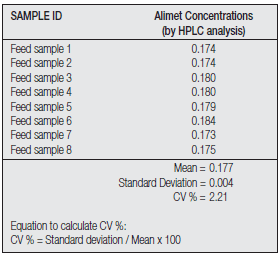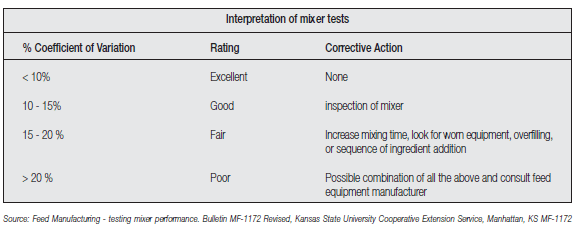Ensuring Optimum Mixability In Feed Manufacturing: Part 5 - Color-coded Tracers, Data Analysis
Color-coded Tracers
Microtracerâ„¢ Rotary detector (Micro Tracers, Inc., San Francisco, CA 94124): Inclusion and subsequent analysis for tracer particles is another method for mixer testing. A sufficient amount of iron filings, colored with a water-soluble die, is added to the mix to result in sixteen counts (particles) per sample, with the sample size ranging between 50 to 100 grams. The iron particles are demagnetized and sprinkled onto a large filter paper. The filter paper is then moistened with ethanol. When spots begin to develop, the paper is transferred to a preheated hot plate or oven and dried. All particles of the same color are counted, noting the total. Variation from the expected number is calculated to determine mixer performance.
As an interim check, other ingredients such as lysine and liquid Alimet feed supplement can be utilized to help determine if the mixer is functioning within an acceptable range of variation. Feed mills routinely assay for Alimet to evaluate mixability due to its relatively low assay CV (3-5%), and the simplicity of the method which uses High Pressure Liquid Chromatography (HPLC).

Data Analysis
The average marker concentration (mean) and variations between samples (standard deviation) are calculated to arrive at a single value described as the coefficient of variation (CV).
Example: A formula calls for 0.175% Alimet. Determine if a good mix has been obtained.
The mean and standard deviation values can be calculated with an inexpensive calculator with the statistical functions. We conclude from this data that the blend was uniform with a CV value of 2.21%
Interpreting the Results
A CV of less than 10% has somewhat arbitrarily
been used as the "cut-off" point for accepting a
batch of feed as being properly mixed. The industry
standard is a maximum CV of 10% for a feed to
be considered adequately mixed. Thus, a desirable
CV for a well-mixed feed, using the salt assay
method, should be at or below 10%. However,
variation in the salt assay procedure may be as high as 5 to 6%, indicating that the actual variation
due to mixing is about 5%. Furthermore, when using a limited number of samples (10 - 12), it can
be expected that occasionally a CV of more than 10% will occur, which may/may not identify an
underlying problem in the mixing process. Thus, these figures may be revised to fit individual mill
standards and quality control policy.

Ensuring Optimum Mixability In Feed Manufacturing: Part 2 - Effect of Mixing Uniformity on Animals Performance
Ensuring Optimum Mixability In Feed Manufacturing: Part 3 - Factors That Affect Mixer Performance
Ensuring Optimum Mixability In Feed Manufacturing: Part 4 - Mixer Testing
Ensuring Optimum Mixability In Feed Manufacturing: Part 6 - Conclusion




